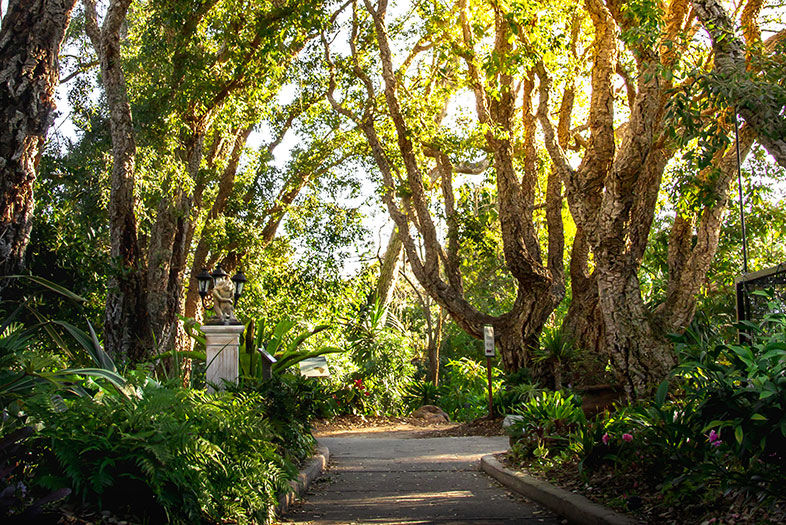Putting Down Roots
When Donald and Gertrude Ingersoll purchased the 16.5-acre parcel of Encinitas in 1917 that would one day become the San Diego Botanic Garden, there were only native plants in sight. The couple changed that, planting eucalyptus trees and taming the wild territory to build a ranch house with the help of friend and architect J. Frank Cullen, a prominent developer of Cardiff-by-the-Sea. (The house still stands today as a museum, and its Walled Garden is used as a wedding venue.) They sold the property to an avocado farmer in 1923, and 20 years later Kansas City transplants Charles and Ruth Larbee scooped it up, plus a neighboring 10 acres, for an estimated $17,850.
For the Birds
Over six steadfast years, the Larbees transformed the property into a quail refuge (Ruth could often be seen in her overalls and green rainboots admiring them in the spring) and botanic garden that Ruth named “El Rancho San Ysidro de las Flores.” They brought in rare plants they’d admired on their world travels—cork oaks (pictured), aloes, dragon trees, southern magnolia, Torrey pine trees—and welcomed scout troops to come learn about them. Charles divorced Ruth in 1950, leaving her to tend the ranch on her own for seven years before she donated the 26.5 acres (by then valued at $98,000) to San Diego County under the condition it be called “Quail Park.” Though she died in 1969, her memory lives on through the Quail Gardens Foundation, an entity created in her honor to oversee the gardens.
How They Operate
In 1970, the “Quail Park Botanic Gardens” officially opened to the public with free admission, subsidized by county tax dollars. That funding was scrapped in 1993, but the foundation reached a deal with the county to continue operating the property, then drummed up excitement (and donations) with its first insect fair and, in 1996, its inaugural Garden of Lights spectacle. That event is still going strong—last Christmas Eve, attendance hit an all-time high of 28,882, in one day accounting for 14 percent of the gardens’ annual attendance. Renamed the San Diego Botanic Garden in 2009, it’s now operated by 31 full-time employees, nine horticulturists, and 48,000 annual volunteer hours. Funding comes from admission, membership programs, a gift shop, plants sales, and fund-raising events like its annual gala.
Worth the Trip
Deemed one of the “Top 10 Gardens Worth Travelling For” at the 2017 North American Garden Tourism Conference, SDBG now sprawls over 37 acres, with four miles of trails and 29 themed gardens that house 4,756 taxa, including 304 species of plants found in no other botanical garden in the world. The most finicky is the corpse flower, which—if kept at a stable 80 percent humidity and 60 degrees—blooms as rarely as once per decade. Native plants remain the easiest to care for and attract passing birds on the Pacific Flyway—111 species were spotted last year alone, and an endangered California gnatcatcher even nested there. And while its current largest plant is a brown-woolly fig (Ficus drupacea), a recently planted New Zealand kauri tree (Agathis australis)—the second largest in the world after the sequoia—is vying for the big honcho title. (Just give it another 100 years.)
Visit the Icon!
230 Quail Gardens Drive, Encinitas sandiegobotanicgarden

Inside the Icon: San Diego Botanic Garden
PARTNER CONTENT
Photo by Lucianna McIntosh
















